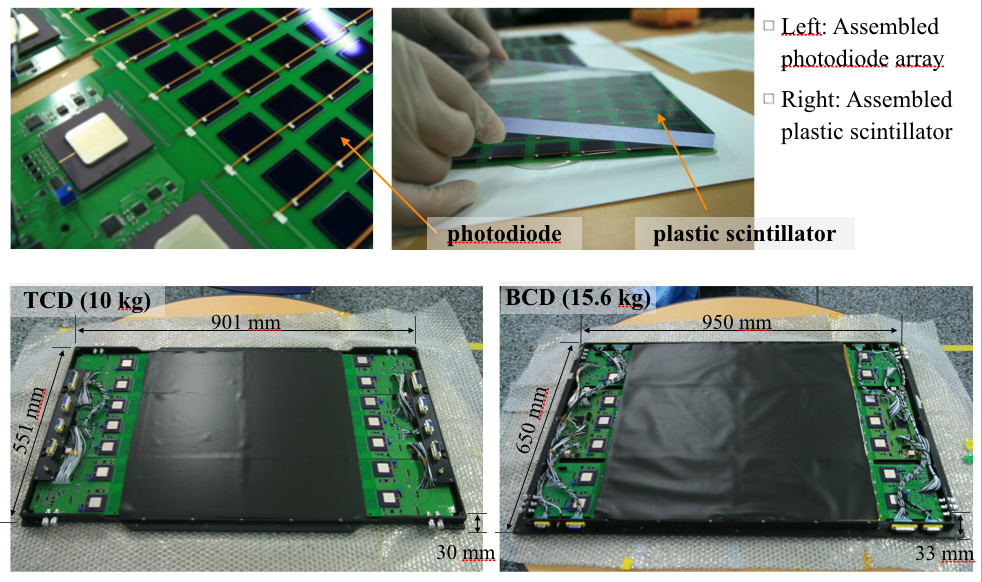ISS-CREAM
 Building on the success of the Cosmic Ray Energetics And Mass (CREAM) balloon flights
Building on the success of the Cosmic Ray Energetics And Mass (CREAM) balloon flightsTCD and BCD
 Kyungpook National University is responsible for Top Counting Detector and Bttom Counting Detector (TCD/BCD).
The TCD/BCD are designed to measure scintillation lights produced when particles pass through the plastic scintillators. The photodiode (PD) has been chosen to convert scintillation lights to electric current. The PD measures not only the scintillation lights but also the ionization energy losses of incident charged particles.
The TCD is located between the carbon target and the Calorimeter, and the BCD is located below the Calorimeter. The TCD consists of a plastic scintillator with 500 x 500 x 5 mm3 dimension and 20 x 20 silicon photodiodes. The BCD is similar to the TCD except that the size of the plastic scintillator is 600 x 600 x 10 mm3. Dimensions of the Al enclosures for the TCD and BCD are 901 x 551 x 29 mm3 and 950 x 650 x 25 mm3, respectively. The mass of the TCD is 9.6 kg and BCD is 15.6 kg, respectively.
The T/BCD can separate electrons from the protons for electron and gamma-ray physics. Electrons can be separated from the protons by using the difference in shower shapes of the electromagnetic and hadronic interactions. Energy information in two dimensions from the photodiodes above and below the Calorimeter can provide a tool to distinguish electrons from protons.
The T/BCD can also give a redundant high energy trigger and a low energy electron trigger.
--
Kyungpook National University is responsible for Top Counting Detector and Bttom Counting Detector (TCD/BCD).
The TCD/BCD are designed to measure scintillation lights produced when particles pass through the plastic scintillators. The photodiode (PD) has been chosen to convert scintillation lights to electric current. The PD measures not only the scintillation lights but also the ionization energy losses of incident charged particles.
The TCD is located between the carbon target and the Calorimeter, and the BCD is located below the Calorimeter. The TCD consists of a plastic scintillator with 500 x 500 x 5 mm3 dimension and 20 x 20 silicon photodiodes. The BCD is similar to the TCD except that the size of the plastic scintillator is 600 x 600 x 10 mm3. Dimensions of the Al enclosures for the TCD and BCD are 901 x 551 x 29 mm3 and 950 x 650 x 25 mm3, respectively. The mass of the TCD is 9.6 kg and BCD is 15.6 kg, respectively.
The T/BCD can separate electrons from the protons for electron and gamma-ray physics. Electrons can be separated from the protons by using the difference in shower shapes of the electromagnetic and hadronic interactions. Energy information in two dimensions from the photodiodes above and below the Calorimeter can provide a tool to distinguish electrons from protons.
The T/BCD can also give a redundant high energy trigger and a low energy electron trigger.
-- Comments
| I | Attachment | History | Action | Size | Date | Who | Comment |
|---|---|---|---|---|---|---|---|
| |
ISS.png | r1 | manage | 266.8 K | 2016-03-20 - 04:49 | JeongminPark | ISS |
| |
TBCD.png | r1 | manage | 986.0 K | 2016-03-20 - 05:09 | JeongminPark | TCD/BCD |
Topic revision: r5 - 2017-10-12 - JooyoungLee
Ideas, requests, problems regarding TWiki? Send feedback


